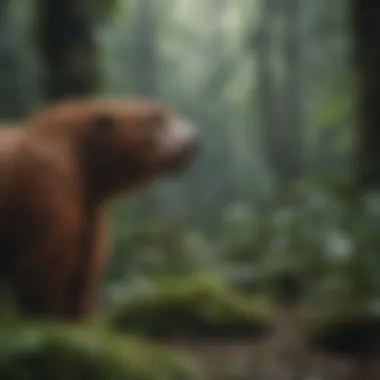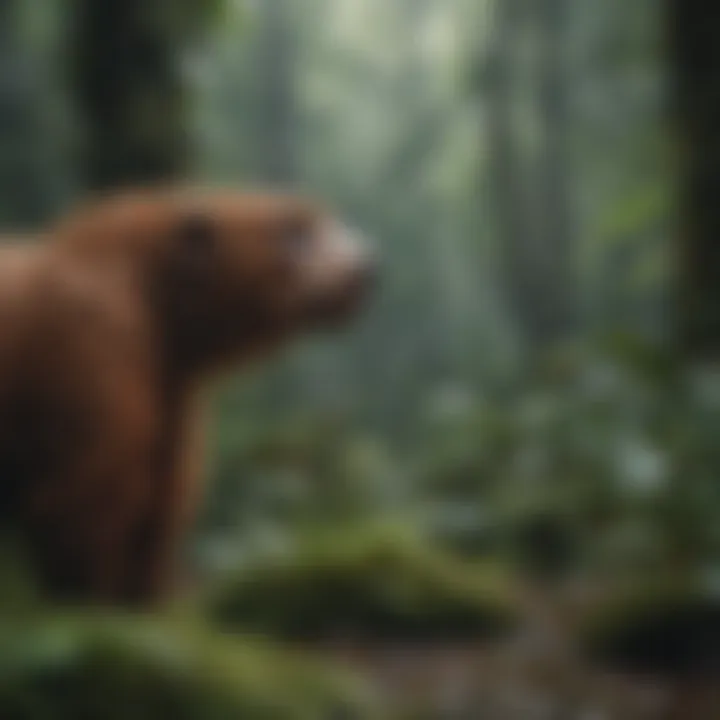Understanding the Intricacies of Rain Forests


Intro
Rain forests are often referred to as the planet's lungs, holding an astonishing amount of biodiversity within their lush canopies. These ecosystems, rich in life, are not just a backdrop for nature's theatrics but instead serve as critical components in maintaining the balance of the Earth's ecology. The complexity of rain forests goes beyond their vibrant flora and fauna; it encompasses a labyrinth of interactions that bind species together in an intricate web of life.
Understanding rain forests is essential not only for ecological studies but also for grasping the pressing issues they face due to human actions. Deforestation, climate change, and exploitation threaten to unravel the delicate ecosystem, with repercussions that extend far beyond their boundaries.
Among the vast green expanses, various species interact in a dynamic manner. For instance, the towering kapok trees provide a habitat for countless creatures, from birds to insects, while also contributing to the forest's structure. Such relationships are examples of nature’s delicate balance, heavily influenced by both environmental conditions and species interdependence.
To fully appreciate the multilayered significance of rain forests, it is vital to explore the diversity present, the roles these ecosystems play, and the blend of crises impacting their survival. This exploration aims not just to inform but to ignite a sense of urgency regarding their preservation.
Rain forests don't just sustain themselves; they sustain the world. Their ability to absorb carbon dioxide and release oxygen underscores their role in combating climate change. Moreover, they house thousands of medicinal plants, countless species yet to be discovered, and serve as vital water catchments for surrounding regions.
In this discourse, we will embark on a journey through the enchanting yet perilous world of rain forests. We will delve into their biodiversity, discuss conservation strategies, and highlight the roles played by various stakeholders—all in an effort to underline the dire need for action in safeguarding these ancient ecosystems.
"In the grand tapestry of Earth’s ecosystems, rain forests are the threads of vibrant green, essential for the integrity of the weave."
As we move forward, our discussions will be both enlightening and crucial for anyone invested in ecological research, education, or conservation efforts. Understanding these forests is the first step towards ensuring their future.
Preface to Rain Forests
Rain forests are often considered the lungs of our planet, playing a crucial role in the overall health of our environment. These vibrant ecosystems are not just a collection of trees; they represent a complex web of life where every organism, from the tallest canopy trees to the tiniest insects, has a role to play. Understanding rain forests is fundamental for anyone concerned about biodiversity, conservation, and climate change.
In this section, we will explore the definitions and characteristics of rain forests, shedding light on their unique traits that set them apart from other ecosystems. Moreover, we will embark on a geographical journey to pinpoint where these lush landscapes can be found across the globe. The significance of this exploration is paramount—by grasping the defining features and locations of rain forests, we can better appreciate their diverse species and the essential services they provide to humanity.
Definition and Characteristics
Rain forests are typically defined by their high rainfall, consistently warm temperatures, and rich biodiversity. Contrary to what one might think, they are categorized into two main types: tropical rain forests and temperate rain forests.
- Tropical Rain Forests: These are located near the equator and are characterized by their lush vegetation, with annual rainfall often exceeding 2000 mm. They’re home to a vast array of plant and animal species, and the climate remains warm year-round.
- Temperate Rain Forests: Found in cooler coastal regions, these forests receive significant rainfall but experience distinct seasons, which affect the flora and fauna. The vegetation often includes towering conifers and deciduous trees.
Both types exhibit specific characteristics:
- Canopy Structure: The upper canopy creates a layer of treetops that can be difficult to navigate. Below this layer lies the understory, which is shaded and often host to various ferns and smaller plants.
- High Biodiversity: Rain forests are famous for their biodiversity. The sheer number of plant and animal species is astounding, with estimates suggesting that half of the world’s terrestrial species can be found in these ecosystems.
Understanding these characteristics helps to emphasize the fragility of rain forests. Their existence hinges on finely balanced ecological conditions, making them vulnerable to any environmental disruptions.
Geographical Distribution
The geographical spread of rain forests is primarily influenced by climate and geography.
- Equatorial Regions: Tropical rain forests thrive in regions close to the equator, predominantly in areas like the Amazon Basin in South America, the Congo Basin in Africa, and Southeast Asia. These locations receive abundant sunlight and rainfall, creating ideal growth conditions.
- Temperate Zones: In contrast, temperate rain forests are found along the coasts of countries like the United States, Canada, and parts of Chile. They tend to exist where moist air meets the land, causing high levels of precipitation.
- Isolated Pockets: Interestingly, rain forests also exist in isolated pockets across different continents due to varying climatic conditions. For instance, the temperate rain forests of New Zealand have distinct species not found elsewhere, showcasing nature's diversity.
In summary, rain forests are vital ecological treasures, manifesting both complexity and beauty. Their unique definitions, characteristics, and geographical distributions set the stage for understanding the immense biodiversity and the plethora of services they offer to the planet. To grasp their essence is to appreciate the delicate balance that sustains life, urging a collective call to action for their preservation.
Biodiversity in Rain Forests
Biodiversity in rain forests is the heartbeat of these ecosystems, showcasing an astonishing variety of life forms and their interactions. This rich tapestry of species underpins not only the health of the rain forest itself but also contributes significantly to global ecological balance. The interplay between flora and fauna generates essential ecological services, such as food production, climate regulation, and nutrient cycling. In this section, we will explore the numerous dimensions of biodiversity, focusing on its intricate web of life.
Flora Diversity
Tree Species
Tree species in rain forests are the giants of these ecosystems. These towering plants provide essential structure and habitat for countless organisms. Notably, species like the Brazil nut tree or kapok tree are hallmark examples. The Brazil nut tree is unique because its seeds can only be dispersed by specific animals, showing the intricate relationship between flora and fauna. In terms of benefits, tree species serve as a crucial carbon sink, helping mitigate climate change. However, the challenge they face is logging, threatening their sustainability.
Understory Plants
Understory plants, often overshadowed by the towering canopy, are a vital component of rain forest biodiversity. These plants thrive in the lower light conditions beneath the forest’s canopy. Species like ferns and small flowering plants support a diverse group of insects and offer food sources for various animals. A key characteristic of understory plants is their adaptation to low light; they possess broader leaves that capture more sunlight. Although often overlooked, their role in soil stabilization and water retention highlights their ecological importance.
Vines and Epiphytes
Vines and epiphytes are the acrobats of the rain forest, skillfully climbing or residing on host trees. Vines, such as lianas, can grow rapidly, intertwining through the forest, creating access pathways for animals. Epiphytes, like orchids and bromeliads, grow on trees but don't harm them, absorbing moisture and nutrients from the air. These species are valuable because they increase structural complexity within the forest. However, their dependence on larger trees means that any destruction of the latter can have dire effects on their survival.
Fauna Diversity
Mammal Species
Mammal species are some of the most charismatic inhabitants of rain forests. From jaguars prowling the underbrush to sloths lazily hanging from branches, these animals play significant roles in maintaining ecological balance. Their mobility aids in seed dispersal, crucial for plant regeneration and diversity. A distinguishing feature is their varied diets; some are herbivores while others are carnivores creating a balanced food web. As keystone species, their disruption could lead to cascading effects through the ecosystem.
Bird Species


Bird species in rain forests create a vibrant symphony of sounds and colors. Species such as the toucan or harpy eagle showcase not just beauty but also ecological function. They serve as pollinators and seed dispersers, often moving between different trees and plants. Their striking beaks are not just for show; they assist with feeding on a variety of fruits and insects, integrating their role into the forest’s health. The challenges they undergo include habitat loss and climate impact affecting their breeding patterns.
Insect Diversity
Insect diversity in rain forests is staggering and crucial for ecological functioning. The sheer number of insects, ranging from beetles to butterflies, illustrates an unseen yet vital part of the ecosystem. Many insects act as decomposers, breaking down organic matter and returning nutrients to the soil. Their unique adaptations, such as camouflage or mimicry, allow them to thrive in such a competitive environment. However, their survival hinges on the health of their habitat, making them sensitive indicators of environmental change.
Biodiversity in rain forests is not merely an array of species; it's a complex network that sustains life.
Ecosystem Services Provided by Rain Forests
Rainforests, often termed the planet's lungs, offer an array of ecosystem services that are vital for maintaining environmental balance. These engimatic forests play a crucial role in supporting life, both within their dense canopies and across the globe. Understanding the specific benefits they provide is necessary for grasping their importance in our ecosystem.
Carbon Sequestration
One of the most notable ecosystem services of rain forests is carbon sequestration. Trees act like sponges, absorbing carbon dioxide from the atmosphere and storing it in their biomass. This process helps mitigate the effects of climate change by reducing the amount of greenhouse gases swirling around in our atmosphere.
As these large expanses of greenery grow, they capture vast amounts of carbon, which is then released slowly back into the atmosphere. The deeper you delve into tree species, the more you realize how various types contribute differently to this process. For instance, the towering Kapok tree is known for its significant biomass, thereby sequestering substantial amounts of carbon. A recent study has revealed that tropical forests store approximately 40% of the carbon found in terrestrial ecosystems, showcasing their paramount importance in combating climate change.
Water Regulation
Rainforests also play an indispensable role in regulating the water cycle. They help manage both local and regional climates by ensuring rainfall patterns remain stable. Trees and plants release moisture back into the atmosphere through a process called transpiration. This mechanism not only contributes to cloud formation but also influences localized weather patterns.
Moreover, their dense roots and foliage help absorb rainwater, which minimizes runoff and erosion. This absorption replenishes groundwater supplies and maintains river flows. The Amazon rainforest, for instance, is attributed with enhancing rainfall patterns as far away as the central plains of the United States. Such a connection highlights how the loss of these forests could mean significant shifts in regional weather systems.
"When forests are cut down or burned, it's like turning off the tap on our water supply."
- Environmental Researcher
Soil Fertility Maintenance
Soil health, often overlooked, is another critical benefit that rain forests provide. The diverse range of organic matter produced by layered vegetation, such as decomposed leaves and fallen fruits, enriches the soil. This layer of organic material acts as a natural fertilizer, aiding the nutrient cycle that supports myriad plant species.
Moreover, the intricate relationship between plants and microorganisms in these regions promotes soil formation and fertility. Host trees support various species of fungi, which in turn enhance nutrient uptake for their roots. This is particularly important for growing crops and sustaining agricultural practices. Areas surrounding rain forests benefit from this increased soil fertility, showcasing a direct connection between forest conservation and agricultural productivity. Without the rain forests, soil erosion becomes more prevalent, leading to decreased soil quality over time.
In sum, acknowledging these ecosystem services highlights the urgency in conserving rain forests for the sake of humanity and nature alike. By preserving these invaluable services, we safeguard our environment for future generations.
The Role of Indigenous Peoples in Rain Forest Ecosystems
Indigenous peoples have been guardians of rain forest ecosystems for centuries, holding a wealth of knowledge that goes beyond mere survival. Their deep-rooted relationships with the land and the intricate web of life within these forests underscore not only their significance in conservation efforts but also in maintaining the ecological balance. Understanding their role sheds light on the importance of integrating traditional practices with modern conservation strategies, thereby preserving biodiversity and cultural heritage.
Traditional Ecological Knowledge
Traditional Ecological Knowledge (TEK) is an invaluable asset arising from the long-standing cultural practices and beliefs of Indigenous communities. This collective wisdom encompasses a variety of concepts, including sustainable harvesting methods, medicinal plant uses, and intricate land management techniques. For instance, many tribes have developed agroforestry methods that replicate forest ecosystems by interspersing valuable crops among native trees. This approach minimizes environmental disruption while maximizing productivity.
The deep understanding that Indigenous people hold about seasonal changes, animal behavior, and plant cycles is pivotal for biodiversity conservation. For example, within some Amazonian tribes, there exists a profound knowledge of over 500 plant species with medicinal properties, passed down through generations. This information is not just key for cultural identity but also crucial for modern medicine, as many pharmaceuticals are derived from these very plants.
"Using traditional ecological knowledge, we can learn how best to manage our forests, ensuring that all species, including humans, thrive together."
Embracing TEK means recognizing the interconnectedness of life within rain forests, blending it with scientific approaches to create holistic solutions to environmental problems. This stands as a testament to what can be achieved when respect for traditional wisdom coincides with contemporary conservation science.
Sustainable Practices
Sustainable practices among Indigenous communities embody a harmonious relationship with nature. These practices are not merely about extraction but focus on renewal and respect for the environment. For instance, techniques such as rotational farming allow the land to restore its fertility, while controlled burns help manage undergrowth and prevent larger wildfires. These methods illustrate an understanding of ecological principles that modern methods often overlook.
Additionally, Indigenous peoples often employ hunting and fishing regulations that reflect seasonal patterns and population dynamics, ensuring these species are not over-exploited.
- Community-based hunting involves cooperation to determine sustainable quotas, fostering a sense of stewardship and responsibility.
- Fishing methods such as using traps that allow smaller fish to escape help maintain population levels.
The importance of these practices extends beyond utilitarian aspects; they represent a worldview that encourages respect for the natural world. With governments and organizations increasingly recognizing the necessity of Indigenous voices and knowledge in land management, there is growing hope for the future of rain forests. By incorporating sustainable Indigenous practices into broader conservation efforts, various challenges like deforestation and habitat loss could be more effectively addressed.
In summary, the role of Indigenous peoples in rain forest ecosystems is characterized by their unique perspectives and sustainable practices that provide solutions to contemporary environmental issues. Their expertise is not merely anecdotal; it's important, practical, and essential in saving rain forests for future generations.
Threats to Rain Forests
Rain forests, often dubbed the lungs of our planet, face numerous threats that put their existence at risk. This section emphasizes the critical need to understand these threats, as they impact not only the ecosystems within but also the broader global environment. Deforestation, climate change, and pollution stand out as the primary culprits. As we unravel the intricate web of life within these forests, we must also grapple with the unsettling reality of the choices humanity has made.
Deforestation
Logging
Logging is one of the most significant drivers of deforestation. To chop down trees for timber may be profitable in the short term, but the long-term consequences spell disaster for biodiversity. A key characteristic of logging is its intensity; trees don’t just vanish from the landscape—they often take entire ecosystems with them. Logging operations may offer immediate economic benefits, making them a common choice for many countries looking to boost their economic footing. However, that prosperity comes at a hefty price.


The unique feature of logging is its dual nature. First, it provides jobs and infrastructure in rural areas, creating local economies that thrive on timber sales. But on the flip side, the relentless pursuit of timber leads to habitat loss, fragmenting the delicate tapestry of life that rain forests support. What’s lost is not just wood, but also countless species that depend on those trees for survival.
Agricultural Expansion
Agricultural expansion is another pressing issue. Expanding fields for crops requires clearing more forest. This choice seems beneficial at first; feeding the growing population is a commendable goal. However, the key characteristic of agricultural expansion is its effect on the land. While some practices might be sustainable, many farms are set up to prioritize immediate yield, turning a blind eye to the consequences.
Moreover, agricultural activities often use monocultures, which reduce biodiversity and make ecosystems more vulnerable. The unique aspect of this expansion is how it serves as a double-edged sword—providing food yet also decimating habitats that nurture diverse species essential for a balanced environment.
Urbanization
Urbanization presents yet another challenge to rain forests. As people flock to cities, land is cleared to make space for housing developments and infrastructure. The characteristic of urbanization lies in its rapid pace—city growth accelerates past what local ecosystems can bear.
Building cities may feel like progress, but the unique feature of urbanization includes increasing pollution and resource strain. City dwellers consume resources from the rain forests and create waste that often flows back into these ecosystems. This juxtaposition of progress and destruction reveals how urbanization, while offering better living conditions for many, simultaneously strips away the livelihoods of countless fragile species residing in the forests.
Climate Change
Impact on Ecosystems
The impact of climate change is not just an abstract concept; it’s a very real threat that alters rain forest ecosystems at their core. Rising temperatures and shifting rainfall patterns affect species distribution and abundance, dismantling the delicate balance that defines these habitats. One major aspect of this impact is the increased incidence of extreme weather events, causing physiological stress on trees and plants.
This key characteristic makes climate change a compelling topic for this article. The temperature fluctuations can disrupt plant flowering and seeding, which is crucial for sustaining animal populations that depend on those plants. The unique impact can lead to cascading effects through the food chain, potentially endangering species that rely on others for survival.
Species Extinction
Species extinction is a dire outcome of our changing climate. As habitats become inhospitable, organisms unable to adapt face extinction. This theme carries a weighty significance—what is lost is not merely a single species, but an entire aspect of biodiversity. Understanding species extinction underscores the urgency of conservation efforts.
The unique part of this issue is its permanence; when a species is gone, it’s not just a gap in a list of animals. It means lost genetic diversity, which can affect everything from crop resilience to ecosystem stability. Consequently, every effort wasted on ignoring extinction leads us one step further into an uncertain ecological future.
Pollution
Chemical Pollutants
Chemical pollutants are yet another invisible enemy threatening the rain forests. Pesticides, fertilizers, and industrial byproducts seep into the soil and waterways, disrupting the natural order. A critical aspect of this pollution is how it affects not only flora and fauna but also humans relying on these ecosystems for sustenance.
The key characteristic of chemical pollutants is their long-lasting presence in the environment. Once introduced, they do not simply vanish; they accumulate, leading to unknown long-term consequences. This interconnectedness highlights the necessity of discussing pollution in the larger context of rain forest threats.
Plastic Waste
Plastic waste embodies a modern dilemma—an excess that doesn’t break down quickly. It often ends up in the rain forests, suffocating plant life and harming animals that ingest it. The unique feature of plastic waste is its persistence in the environment; it can last for centuries, disrupting ecosystems long after it was discarded.
Its implications for rain forests are significant. Ecosystems that live in harmony may be thrown off balance as plastics break down into microplastics, which have been shown to enter the food chain. Recognizing the consequences of plastic waste on rain forests is critical for building a disciplined approach toward waste management and consumer habits.
Conservation Strategies for Rain Forests
Conservation strategies for rain forests are vital for maintaining the intricate balance of these ecosystems. Rain forests are not just a collection of trees and animals; they are vibrant habitats that support an astonishing variety of life and provide essential ecological functions. The degradation of these areas can lead to dramatic losses, both ecologically and culturally. Thus, implementing effective conservation strategies is more pressing than ever to ensure that future generations will still experience the wonders of these lush environments.
Protected Areas and Reserves
Creating protected areas and reserves is one of the most effective conservation strategies employed worldwide. These designated spaces serve as sanctuaries for wildlife and help preserve biodiversity by restricting human activities that could damage the ecosystem. It’s like putting up a "do not disturb" sign for nature.
Many countries have faced challenges in establishing these protected areas effectively. A lack of funding, poor management, or even conflicts with local communities can all hinder the success of these initiatives.
"Protected areas should be more than just lines on a map; they require active management and community support to thrive."
The size and position of these areas are crucial. The bigger, the better, as larger reserves often support more diverse species and ecosystems. Not to forget that connectivity between reserves can promote genetic diversity among species. Keeping wildlife corridors permeable allows for animal migrations and movement, essential for ecological health.
Sustainable Forestry Practices
Sustainable forestry practices are another key component of conservation strategies. Traditional logging can wreak havoc on rain forest ecosystems, leading to habitat destruction and increased carbon emissions. By implementing sustainable practices, we can strike a balance between economic needs and environmental preservation.
These practices include:
- Selective logging, minimizing the impact on the surrounding environment.
- Enrichment planting, where native trees are reintroduced to logged areas, enhancing biodiversity.
- Certification programs that hold companies accountable for their practices, such as the Forest Stewardship Council.
Adopting sustainable forestry means that we can produce timber without devastating the very ecosystems that provide countless benefits to society. It necessitates a shift in mindset from exploitation to stewardship.
Community-Based Conservation
Community-based conservation leverages the knowledge and participation of local populations in protecting their environment. Indigenous and local communities have often lived in harmony with rain forests for centuries, possessing invaluable ecological knowledge. This strategy shifts the focus from external management to inclusive cooperation.


Empowering communities can be as simple as:
- Offering training programs on sustainable practices.
- Involving locals in decision-making regarding land use.
- Recognizing their rights to land and resources.
When communities are engaged, they are often the best protectors of their environment. When people have a stake in their land's health, the likelihood of responsible stewardship increases significantly.
In summary, the combination of protected areas, sustainable forestry, and community engagement forms a robust framework for conserving rain forests. Each element contributes uniquely, but together, they foster resilience. The adoption of these strategies not only preserves biodiversity but also supports local economies and strengthens global efforts against climate change.
International Policies and Programs
International policies and programs regarding rain forests play a crucial role in shaping global conservation efforts. The complexity of these ecosystems demands a multifaceted approach, encompassing legislation, funding, research collaboration, and public education. With rain forests being essential for global biodiversity, carbon storage, and climate regulation, the need for cohesive international cooperation is more pressing than ever.
Global Initiatives
Several global initiatives have been launched to address the alarming rate of deforestation and degradation of rain forests. One significant initiative is the United Nations REDD+ (Reducing Emissions from Deforestation and Forest Degradation) program. This program incentivizes developing countries to reduce emissions by conserving their forests, creating a financial framework that encourages sustainable practices.
Another key initiative is the Convention on Biological Diversity (CBD), which emphasizes the conservation of biological diversity, sustainable use of its components, and fair sharing of benefits arising from genetic resources. This treaty holds nations accountable for taking action to protect their biodiversity, including the vital ecosystems found in rain forests.
In addition to these treaties, organizations like the World Wildlife Fund (WWF) and Rainforest Alliance work tirelessly towards raising awareness, providing resources, and developing practical strategies for protecting rainforest habitats. They advocate for sustainable forestry practices and promote eco-friendly consumer choices, helping individuals make informed decisions that directly contribute to forest conservation.
Agreement Ratifications
The ratification of international agreements is a pivotal step in committing to the preservation of rain forests. Countries that sign these treaties not only gain access to funds and expertise but also commit to enacting national policies that align with global goals.
For instance, the Paris Agreement, although primarily focused on climate change, implicitly supports rain forest conservation by emphasizing the need to reduce greenhouse gas emissions, which are closely tied to deforestation activities. When countries ratify such agreements, they create a framework that guides domestic policy toward climate resilience and sustainable use of natural resources.
Moreover, the successful implementation of these agreements often hinges on the cooperation of local governments, indigenous communities, and non-governmental organizations. Engaging diverse stakeholders ensures that the specific needs and knowledge of those most affected by policy decisions are incorporated. This collaborative effort is essential for establishing accountability and promoting transparency in the enforcement of conservation strategies.
"The future of our planet relies on the involvement and dedication of all levels of society, from international leaders to local communities."
The involvement of governments in global initiatives and their commitment through agreement ratifications ultimately shape how effectively rain forests can be protected. Enhancing the cooperative spirit among nations ensures a unified front against the threats facing these ecosystems, which is necessary as the implications of rain forest degradation extend far beyond their borders. Consequently, it is imperative for nations to not just sign agreements, but actively pursue implementation, monitoring, and reporting to foster enduring change.
As we delve deeper into the conversation around rain forest conservation, understanding the intricate tapestry of international policies and programs becomes essential. These frameworks not only set the stage for collaborative efforts but also highlight the collective responsibility that humanity holds toward the preservation of our planet's vital ecosystems.
Local and Global Impacts of Rain Forest Loss
The gradual disappearance of rain forests sends shockwaves not just through the ecosystems directly affected, but also across global landscapes. These verdant expanses are more than just a collection of trees; they are complex systems that hold immense significance for both local communities and the world at large. Understanding the implications of rain forest loss requires looking into two main areas: biodiversity loss and cultural implications.
Biodiversity Loss
When rain forests are felled, a grave threat looms over the biodiversity nestled within their depths. These forests are home to over half of the planet's terrestrial species, making their loss catastrophic at a biological level. The extinction rates of various species have accelerated alarmingly, with many plants and animals unable to adapt to the rapid changes leaving their habitats. Here are some consequences of this biodiversity loss:
- Habitat Destruction: For countless species, habitat destruction means a constant battle for survival. Deforestation shrinks their living spaces, pushing many species toward extinction.
- Disruption of Ecosystem Balance: Ecosystems demand balance, and the loss of any single species can have a ripple effect. Predators, prey, and flora rely on one another; disturb that relationship, and the entire ecosystem may collapse.
- Loss of Medicinal Resources: Many modern medications derive from plants found in rain forests. With each tree felled, we risk losing remedies that could treat diseases or help future generations.
In sum, when we lose biodiversity in rain forests, we not only melt the intricate web of life that exists there but also jeopardize our own health and well-being.
Cultural Implications
The decline of rain forests extends beyond ecological impacts, reaching into the heart of cultures that depend on these ecosystems for their identity and existence. Indigenous peoples, who have thrived for centuries by living in harmony with these environments, face significant challenges. Consider the following:
- Displacement: As rain forests are cleared for agriculture or urban development, whole tribes find themselves forced from their ancestral lands, disrupting their way of life.
- Loss of Traditional Knowledge: Indigenous communities possess an intimate understanding of rainforest ecosystems, passed down through generations. This knowledge is invaluable for sustainable practices, but it vanishes as communities are displaced or diminished.
- Erosion of Cultural Identity: The intrinsic connection between these communities and the land is profound. With the loss of rain forests, not only is their livelihood affected, but so is their cultural heritage, leading to a weakened sense of identity.
"The rainforest is not just a resource for us; it is our ancestor, our history, our culture. When it disappears, so do we."
Culmination
The conclusion serves as a vital component in the discourse on rain forests. It brings the various threads of discussion together, emphasizing how rain forests are not merely collections of trees, but complex ecological systems that embody significant cultural, environmental, and global implications. Understanding the future of these ecosystems is not just an academic exercise but a critical need in the face of looming threats.
The Future of Rain Forests
The future of rain forests is intricately linked to our collective actions today. Among the various factors influencing these environments, climate change stands out. Keeping the global temperature rise below the critical 1.5 degrees Celsius threshold is a must, as even minor increases can lead to drastic shifts in rainfall patterns and temperature that could decimate fragile ecosystems.
The preservation efforts underway must be multifaceted. For example, the implementation of reforestation projects like the Bonn Challenge seeks to restore 150 million hectares of degraded and deforested land by 2020. Such global initiatives offer seeds of hope.
Furthermore, advancing sustainable practices in forestry and agriculture holds enormous potential. Farmers adopting agroforestry techniques can yield crops while simultaneously protecting biodiversity. When communities are engaged and educated about the importance of rain forests, their participation becomes crucial—participatory management strategies have shown promising results in several regions.
For indigenous peoples, the future is often intertwined with their rights and freedoms. Recognizing their role as stewards of the land can lead to better conservation outcomes. Their traditional practices honed over centuries often align closely with sustainable land management principles.
Call to Action
The time to act is now. While the challenges are immense, they are not beyond our reach if we unify efforts at local, national, and global levels. It starts with raising awareness and education regarding rain forests among students, researchers, and the public at large.
- Advocate for policies: Support legislators who commit to protecting these vital ecosystems through legislation.
- Participate in local efforts: Join local conservation organizations or initiatives aimed at preserving biodiversity or reforestation projects.
- Reduce your footprint: Simple lifestyle changes, such as reducing paper use or choosing sustainable products, can collectively add up to a significant impact.
- Engage with technology: Use platforms like reddit.com to connect with activists and educate yourself on conservation techniques.
"The greatest threat to our planet is the belief that someone else will save it." — Robert Swan
Rain forests are in peril, and while the statistics are daunting, genuine change is feasible. Drawing inspiration from past successes might light the path ahead. A collaborative spirit and actionable goals will steer us toward a future where rain forests can thrive alongside human societies.















